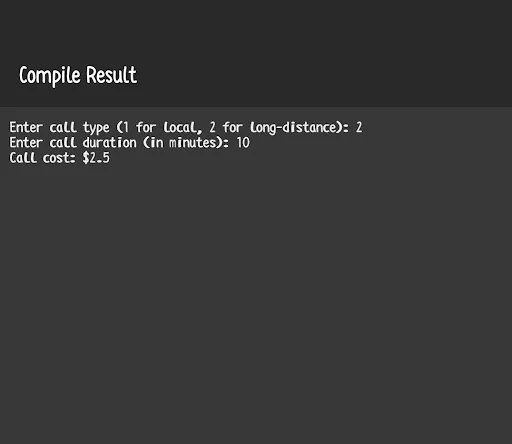Telephone Billing System in C++
Creating a telephone billing system in C++ involves managing customer information, call records, and calculating bills based on usage. Here's a simplified outline of how you might approach this project:
1. **Set Up Environment:**
- Install a C++ development environment or IDE, such as Code::Blocks or Visual Studio.
2. **Data Structures:**
- Define data structures to store customer information and call records. You might use classes and structs for this purpose.
3. **Customer Information:**
- Create functions to add, edit, and delete customer information, including name, address, phone number, and plan details.
4. **Call Records:**
- Implement functionality to record call details, including call duration, call type (local, long-distance), and time of the call.
5. **Billing Calculation:**
- Calculate the cost of each call based on the call type and duration.
- Maintain a running total for each customer's bill.
6. **Reports:**
- Generate reports, such as customer statements, that summarize call details and billing information.
7. **User Interface (Optional):**
- Develop a text-based or graphical user interface to interact with the billing system.
8. **Error Handling:**
- Implement error handling for invalid inputs or other issues.
Here's a simplified example of a C++ program to calculate the cost of a call:
```cpp
#include <iostream>
using namespace std;
int main() {
int callType; // 1 for local, 2 for long-distance
double callDuration;
cout << "Enter call type (1 for local, 2 for long-distance): ";
cin >> callType;
cout << "Enter call duration (in minutes): ";
cin >> callDuration;
double cost;
if (callType == 1) {
cost = callDuration * 0.10; // Local call rate
} else if (callType == 2) {
cost = callDuration * 0.25; // Long-distance call rate
} else {
cout << "Invalid call type." << endl;
return 1;
}
cout << "Call cost: $" << cost << endl;
return 0;
}
```
Output
This is a simplified example, and in a real billing system, you'd need to manage customer records, call history, and generate more comprehensive reports. You can expand on this foundation to create a more complete telephone billing system.
.png)



